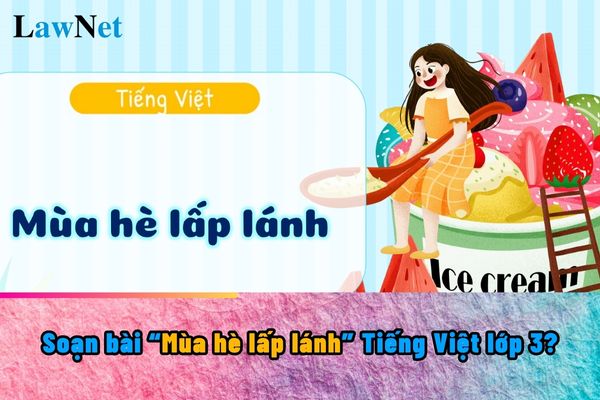Guidelines on preparing the lesson Mùa hè lấp lánh for grade 3 students in Vietnam
Guidelines on preparing the lesson Mùa hè lấp lánh for grade 3 students in Vietnam
Mùa hè lấp lánh is one of the lessons that grade 3 students will study in Week 4, Lesson 7, grade 3 Vietnamese language on pages 34-35 (Kết nối tri thức curriculum)
Teachers, parents, and students can refer to the following guidelines to prepare the lesson:
|
Guidelines on preparing the lesson Mùa hè lấp lánh for grade 3 students in Vietnam * Main Content and Meaning of the Lesson |
**Note: The information is for reference only./.

Guidelines on preparing the lesson Mùa hè lấp lánh for grade 3 students in Vietnam (Image from the Internet)
>>> See Also: Guide to Preparing the Lesson "Đồng dao mùa xuân" for grade 7 students in Vietnam
>>> See Also: Required Achievements in grade 5 Vietnamese Language
>>> See Also: Reading Speed Requirements for Grade 3 Students in Vietnam under the New Curriculum
>>> See Also: Required Achievements in grade 4 Vietnamese Language according to 2018 Curriculum
What are methods for teaching reading for grade 3 Vietnamese Language for primary students in Vietnam?
According to sub-section 3, Section 6 of the General Education Program for Literature issued with Circular 32/2018/TT-BGDDT, the reading teaching method for primary students learning Vietnamese language in grade 3 is as follows:
(1) Teaching Comprehensive Reading of Texts in General:
Students are required to read the entire text directly, paying attention to observe the formal features of the text to have an overall impression and summarize the main content of the text;
Organize for students to seek, discover, analyze, infer the meaning of the information, messages, viewpoints, attitudes, thoughts, feelings, emotions, etc., conveyed in the text; guide students to relate, compare texts, connect the text with the historical, cultural, social context, connect the text with personal experiences of the students, etc., to understand better the value of the text, and apply those values into their personal beliefs and behaviors in daily life.
(2) Teaching Comprehensive Reading of Literary Texts: Literary texts are a type of text, so teaching comprehensive reading of literary texts must also follow the general text comprehension method.
However, literary texts have their own characteristics, so teachers must organize for students to explore and decode literary texts according to a process suitable to the characteristics of artistic texts.
Students need to be guided and practiced in reading literary works by a process ranging from recognizing textual language to discovering the world of artistic figures and seeking and summarizing the content and meaning; skills to find and interpret the relationship between the “whole” and the “part” details of the text, detecting the integrity, unity of content, and completeness of the form of the literary work.
The teaching method must focus on activating positive, creative reading in the reader.
Guide and encourage students to be proactive, confident, and play the role of “co-creator” in receiving the work; enthusiastically participate in constructing meaning for the text; know how to compare and contrast, expand connections, mobilize individual knowledge, and apply their own life experiences to read, experience literature, and discover ethical, cultural, and philosophical values for living intentionally.
When teaching reading comprehension, teachers should help students discover the message and meaning independently, contributing to filling the “gaps” in the text. Teachers can offer suggestions but should not replace students’ thoughts with their analysis and evaluation; avoid rote learning and minimize mechanical memorization.
Use diverse types of questions at various levels to implement differentiated teaching and guide students in reading comprehension, forming reading skills.
Depending on the students in each grade level and the genre of the literary text, apply appropriate teaching methods, techniques, and forms such as:
Expressive reading, role reading, storytelling, role-playing to solve a situation, acting, using questions, guiding note-taking during reading with note cards, learning cards, reading logs, organizing student discussions about the text, adapting literary works from one genre to another, drawing, making films, experiencing situations the characters have undergone, etc.
Other teaching methods such as dialogue, question and answer, lecture, problem-posing, etc., should be appropriately applied according to the requirement of developing students' competencies.
What are cases in which primary students in Vietnam are eligible for Certificates of Merit?
According to Article 13 of the Regulations on Evaluation of Primary School Students issued with Circular 27/2020/TT-BGDDT:
Commendation
1. The principal awards certificates of merit to students:
a) Commendation at the end of the school year:
- Award the title of Excellent Student for those achieving Outstanding Completion in educational outcomes;
- Award the title of Exemplary Student for those achieving Good Completion and having outstanding achievements in at least one subject or significant progress in at least one quality or competence, recognized by the class collective.
b) Special commendation: for students achieving exceptional accomplishments during the school year.
2. Students with special achievements are considered by the school for higher commendation.
3. School administrators and teachers can send letters of commendation to students for their efforts and achievements in learning, quality, competence development, or good deeds.
Thus, students who achieve the title of Excellent or Exemplary Students will receive certificates of merit from the principal at the end of the school year.
>> Download View the General Education Program for Literature issued with Circular 32/2018/TT-BGDDT
See Also: Guide to Preparing the Lesson "Synonymous Words and Sentences" for grade 5 students in Vietnam
See Also: How to Write a Descriptive Essay on Landscapes for grade 5 students in Vietnam
See Also: Drafting an Outline for a Landscape Descriptive Essay for grade 5 students in Vietnam
See Also: Top 10 Best Short Descriptive Essays on Landscapes for grade 5 students in Vietnam
See Also: Guide to Preparing the Lesson "Trước cổng trời" for grade 5 students in Vietnam

